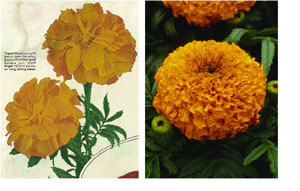1/25/2012
Marvelous African Marigolds
Bob Pierce, Ph.D. & Matthew Blanchard, Ph.D.
In recognition of All-America Selections 80th anniversary, GrowerTalks is featuring a series of Culture Notes articles on previous AAS winners during 2012.
Marigolds have always been popular with home gardeners and they rank among the top 10 bedding plants produced in the United States. Four species of marigolds are commonly grown commercially: African or American marigolds (
Tagetes erecta), French marigolds (
T. patula), sweet-scented marigolds (
T. lucida) and signet marigolds (
T. tenuifolia). African marigolds are one of the prevalent species. Syngenta Flowers offers a wide range of African Marigold genetics, ranging from dwarf series like Antigua, which is ideal for high-density production, to the more vigorous AAS-winning Moonsong Deep Orange, which excels in larger containers. Regardless of the variety you choose, following these culture notes should help you produce a healthy and beautiful marigold crop.
The first marigold variety to win an AAS award (a nd a Gold Medal) was Guinea Gold from Watkins & Simpson in 1933 (left). The last winner was Moonsong Deep Orange African Marigold from Syngenta in 2010.
nd a Gold Medal) was Guinea Gold from Watkins & Simpson in 1933 (left). The last winner was Moonsong Deep Orange African Marigold from Syngenta in 2010.
African marigolds are facultative short-day plants. This means that although they will flower under long days, flowering is accelerated when grown under short days. There’s variation among varieties in their sensitivity to day length. For example, the Antigua and Inca II series from Syngenta are affected relatively less by day length compared to Moonsong, Moonstruck and Perfection. Varieties that are day-length sensitive can be induced to flower early by growing young plants under a 9-hour photoperiod for 2-3 weeks and then transferring them to long days. If marigolds are grown under short days throughout production, plants may be too compact at flowering and not fill out the container size.
Germination: Maintain media temperature at 72F-75F (22C-24C) and relative humidity at 100% until radical emergence. Expect emergence within 3-5 days. After emergence, reduce temperature to 68F-70F (20C-21C) and humidity to 40%. Seeds can be covered with a thin layer of medium vermiculite to maintain media moisture levels.
Plug bulking: Beginning with cotyledon expansion and progressing through expansion of true leaves, light levels should be maintained below 2,500 foot candles. Maintain a media pH at 6.2 to 6.5 and an EC at 0.5 to 1.0 mS/cm in a saturated media extract (SME). Temperature should be 68F-70F (20C-21C) for the first two weeks of bulking and then gradually reduced to 62F-65F (17C-18C). Allow the growing media to dry down to level 3 between irrigations and avoid letting plants wilt.
Fertilize 1 to 2 times per week at 100 to 150 ppm nitrogen with a calcium-based fertilizer, maintaining a media EC of 0.5-1.0. Monitor boron levels in the media to ensure that they are least 0.5 ppm. Plug time for finishing 288-cell trays at an average daily temperature (ADT) of 65F (18C) is usually 4 weeks.
Finish bulking and flower initiation: Marigolds are commonly transplanted into packs or 4-in. containers. Use a peat-based growing media. Avoid planting plugs too deep and make sure the top of the plug is even with the surface of the growing media. Night temperature should be maintained at 55F-65F (13C-18C) and day temperatures at 65F-70F (18C-23C). High temperatures can cause the flower head size to be small. Some varieties are sensitive to low temperature and new growth will appear bleached when plants are grown too cool. Provide light levels of 4,000-4,500 foot candles. Finishing time from transplant of 288-cell plugs grown at an ADT of 68F (20C) and under a daily light integral of 14-16 mols·m-2·d-1 varies among varieties, but is generally 7-8 weeks.
Monitor media pH regularly to ensure it is between 6.2 and 6.5. A pH of less than 6.0 may induce iron and manganese toxicity. Alternate between a calcium-based (15-0-15) and an ammonium-based (20-10-20) fertilizer at 150-200 ppm nitrogen. Maintain a media EC at 1.0. Vegetative growth will be encouraged by excessive ammonium applications. Provide good air circulation during production to allow plants to dry down between irrigations.
Plant height of marigolds can be controlled by managing temperature, light, irrigation frequency and fertilizer regimen. For chemical height control, 1 to 2 sprays of B-Nine at 2,500-5,000 ppm are effective at suppressing stem extension. Marigolds also respond to A-Rest, Bonzi, Sumagic or a tank mix of B-Nine and Cycocel.
Common insect pests include spider mites, thrips, leafminers, aphids and whiteflies. Scout plants regularly and use appropriate chemical control materials such as Flagship, Citation and Avid integrated with biological products. Common diseases of marigold include alternaria leaf spot, botrytis and pythium. Endeavor, Palladium, Daconil, Subdue MAXX, Medallion and Heritage are products that are effective in managing common diseases.
GT
Bob Pierce is a plant breeder and Matthew Blanchard is a technical services specialist with Syngenta Flowers, Inc., in Gilroy, California. They can be reached at bob.pierce@syngenta.com and matt.blanchard@syngenta.com.